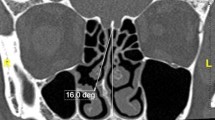Abstract
Nasolacrimal duct injury is a rare complication of rhinoplasty. Detailed regional anatomy knowledge is mandatory to avoid this complication. To display a reference line to protect the nasolacrimal duct from injury during lateral osteotomy, dacryocystography images of 10 patients who underwent rhinoplasty surgery at the authors’ clinic were obtained. Lateral osteotomy lines and a line from the medial canthus to the alar groove were marked with radio-opaque wires before procedures. Horizontal and sagittal distances from these lines to the nasolacrimal duct were measured at the beginning, midpoint, and end of the nasolacrimal duct. No sign of nasolacrimal duct injury was observed postoperatively. The mean horizontal distances from the osteotomy lines to the nasolacrimal duct entrance, midpoint, and exit were respectively 0.23 ± 0.12 cm, 0.25 ± 0.11 cm, and 0.24 ± 0.11 cm, and the mean sagittal distances were respectively 0.61 ± 0.21 cm, 1.96 ± 0.28 cm, and 2.38 ± 0.32 cm. The mean horizontal distances from the medial canthus–alar groove line to the nasolacrimal duct entrance, midpoint, and exit were respectively 0.57 ± 0.1 cm, 0.51 ± 0.1 cm, and 0.46 ± 0.13 cm, and the mean sagittal distances were 0.91 ± 0.27 cm, 1.34 ± 0.27 cm, and 1.79 ± 0.3 cm. The osteotomy lines and the nasolacrimal duct were closest in the medial canthal region. The imaginary line from the medial canthus to the junction of the alar wings and cheek was always lateral and anterior to the nasolacrimal duct. Considering the three-dimensional shape of the nose, especially its projection, placement of lateral osteotomies medial to the medial canthus-alar groove line would decrease the risk of nasolacrimal duct injury.
Level of Evidence IV
This journal requires that authors assign a level of evidence to each article. For a full description of these Evidence-Based Medicine ratings, please refer to the Table of Contents or the online Instructions to Authors www.springer.com/00266.






Similar content being viewed by others
References
Cies WA, Baylis HI (1976) Epiphora following rhinoplasty and Caldwell-Luc procedures. Ophthalmic Surg 7:77–81
Flanagan JC (1978) Epiphora following rhinoplasty. Ann Ophthalmol 10:1239–1242
Flowers RS, Anderson R (1968) Injury to the lacrimal apparatus during rhinoplasty. Plast Reconstr Surg 42:577–581
Goldan O, Georgiou I, Haik J, Tessona A, Winkler E (2008) Lacrimal fistula 10 years after closed cosmetic rhinoplasty: case report. Aesthetic Plast Surg 32:153–154. doi:10.1007/s00266-007-9021-x
Lavine DM, Lehman JA, Jackson T (1979) Is the lacrimal apparatus injured following cosmetic rhinoplasty? Arch Otolaryngol 105:719–720
Osguthorpe JD, Hoang G (1991) Nasolacrimal injuries: evaluation and management. Otolaryngol Clin North Am 24:59–78
Cohen NA, Antunes MB, Morgenstern KE (2010) Prevention and management of lacrimal duct injury. Otolaryngol Clin North Am 43:781–788
Bolger WE, Parsons DS, Mair EA, Kuhn FA (1992) Lacrimal drainage system injury in functional endoscopic sinus surgery: incidence, analysis, and prevention. Arch Otolaryngol Head Neck Surg 118:1179–1184
Meyers AD, Hawes MJ (1991) Nasolacrimal obstruction after inferior meatus nasal antrostomy. Arch Otolaryngol Head Neck Surg 117:208–211
Osguthorpe JD, Calcaterra TC (1979) Nasolacrimal obstruction after maxillary sinus and rhinoplastic surgery. Arch Otolaryngol 105:264–266
Pilanci O, Ucar C, Kuvat SV, Kilic A (2010) An uncommon complication of septorhinoplasty, acute dacryocystitis. Aesthetic Plast Surg 34:392–393. doi:10.1007/s00266-009-9411-3
Thomas JR, Griner N (1986) The relationship of lateral osteotomies in rhinoplasty to the lacrimal drainage system. Otolaryngol Head Neck Surg 94:362–367
Unlu HH, Goktan C, Aslan A, Tarhan S (2001) Injury to the lacrimal apparatus after endoscopic sinus surgery: surgical implications from active transport dacryocystography. Otolaryngol Head Neck Surg 124:308–312. doi:10.1067/mhn.2001.112433
Uzun L, Ugur MB, Peksoy I, Cabuk M, Cinar F (2005) The effect of lateral osteotomy of septorhinoplasty on nasolacrimal duct functions: a radionuclide imaging study. Am J Rhinol 19:388–394
Yigit O, Cinar U, Coskun BU, Akgul G, Celik D, Celebi I, Dadas B (2004) The evaluation of the effects of lateral osteotomies on the lacrimal drainage system after rhinoplasty using active transport dacryocystography. Rhinology 42:19–22
Author information
Authors and Affiliations
Corresponding author
Rights and permissions
About this article
Cite this article
Tercan, M., Yesiladali, G., Ciloglu, S. et al. Topographic Evaluation of the Medial Canthus—Alar Groove Line in Terms of Determining the Boundaries of Lateral Osteotomies. Aesth Plast Surg 37, 34–38 (2013). https://doi.org/10.1007/s00266-012-9985-z
Received:
Accepted:
Published:
Issue Date:
DOI: https://doi.org/10.1007/s00266-012-9985-z




